 |
| Gabe Brown had four years of crop failures, which made him change his methods and emphasize cover crops. |
Ridiculous
Let's start by dismissing the two ridiculous soil amendments, highly recommended by word-of-mouth, but useless for the soil:
- Egg shells are made of calcium but they do not blend with the soil. They might be picked up by birds but do not affect the soil. Like meat products, they may attract the wrong crowd.
- Epsom Salt is promoted by Martha Stewart - world famous
gardenercook and hostess. The compound is a good bath salt and dissolves instantly in water. I bought an economy 8-pound bag and let half of it fall into the water. Not on purpose! It dissolved into the water and vanished, just like my toenials. No, I made that up. We use it for foot soaks. The Epsom Salt Council recommends it for every plant imaginable, but that is seldom the case.
The Bad
Foods are not a good idea since they promote a distinctive and unpleasant garbage can aroma in the garden area. That is why most composters will stick to leafy matter that does not attract raccoons, skunks, and bears.
Chemical fertilizers can have a temporary impact on plants but they slow down or stop God's Creation process. Man-made fertilizers are toxic. Walk down that fertlizer aisle and inhale.
 |
| Decades ago, the Salatin family began building the soil, which had been stripped bare from predatory farming. |
 |
| Chickens hunt for food in the heavily manured fields. This reduces pests and fragrance, preparing the chickens for market. |
The Good
I am willing to share decades of reading and experience with everyone, which should save time and effort for some, incite curiosity among others.
- Save time! Soil amendments - whether finished or raw compost, leaves, manure, shredded wood, plant material, or all those exotic materials listed by Rodale Press - can be left on top of the soil, where God's own sanitation crew will pull it down up to the soil's capacity. Some common sense should be used for the kinds of manure, the freshness of the bouquet, and the amounts.
- Red Wiggler earthworms will pull down organic matter, dig, aerate, and fertilize for free. I added them early to the entire yard, and the results were immediate.
- Leaves are the foundation of all soil fungi, which are the network builders in feeding all plant roots in the yard. Leaves are mostly carbon, which should not be scorned. Fungi need carbon to grow, so why pay money or exert effort to haul carbon sources away.
- Pine Needles have a pleasant aroma for a long time. They can be a perfect mulch, not allowing any weeds through, but some gardeners fear they are too piney. I covered one garden deep and hardly any weeds came up - and even that took some time. But I grew Hostas, Pokeweed, and Blackberries there. Books say - do not overdo pine needles. I suppose it is good not to use them by the truckload, except where suppressing weed growth is a virtue.
- Coffee grounds add nutrition to the soil. Some people get pounds of them from coffee shops. I just toss the coffee didees into the rainwater barrel. Every so often a rich mixture of rainwater, grounds, and paper soak the bird bushes near our window. I dote on those bushes so they serve as shade and as perches for birds when feeding and entertaining us.
- Cover crops are great for the soil and for weed suppression. I overwhelmed myself with Buckwheat last year, but it built up the soil and elbowed all weeds aside. Buckwheat dropped enough seed to come back and grow six feet tall this year. All growing roots improve the soil.
- Weeds are powerful in improving the soil. Invasive weeds are not fun (English Ivy); nor are toxic ones (Poison Ivy, Giant Hogweed, Poison Hemlock). But deep taproots should not be scorned (dandelion, Poke) since they contribute so much to soil building as they shed organic matter and feed the beneficial fungi. I let Pokeweed grow modestly in the rose garden and then prune it back, but wildly in the back to feed the birds. Dandelions are herbs, so they grow where they wish.
- Newspapers, Cardboard. They must improve the soil because I have to replace them as weed blockers. Cardboard lasts the longest. I hold down both with shredded wood.
- Shredded Wood Mulch is best when used without dyes. I am not sure what chemicals are included in those dyes, but coloring wood is akin to spraying the lawn green. Wood mulch holds down the newspapers and cardboard, limits the sun germinating weeds, keeps moisture in the soil, and decomposes into the soil.
- Tree stumps and logs are ideal when borrowed from people removing trees from their property. Stumps are primarily food zones for all kinds of creatures, where the soil meets the wood. They also serve as perches for birds, bases for solar lights, and modular fences.
 |
| This is the best single book on the soil food web. Lowenfels realized the folly of chemical gardening. |
 |
| Those who study this book will be decades ahead of the rest, but it is not easy reading. |
One gigantic effort is not going to convert a property overnight. Who has the energy or materials to do that? Instead, a regular application of natural ingredients will build the soil over time.
I asked neighbors for newspapers and received stacks of them, used those, and then areas to use stacks more. When I had plenty of paper from a small truckload of them, a second load arrived. Now I open the front door a crack and yell "No more newspapers!" They laugh.
Sometimes I appear at a neighbor's door with a bunch of roses in a paper cup. "Here are your newspapers back." They like that as much as I like their contributions.
YouTube
One way to study this topic is to search YouTube for organic gardening advice. I am linking a few for starters.
Gabe Brown on Soil Health - Cover Crops
Joel Salatin Polyface Farm
Joel Salatin - Building the Soil
Soil Carbon Cowboys
I asked neighbors for newspapers and received stacks of them, used those, and then areas to use stacks more. When I had plenty of paper from a small truckload of them, a second load arrived. Now I open the front door a crack and yell "No more newspapers!" They laugh.
Sometimes I appear at a neighbor's door with a bunch of roses in a paper cup. "Here are your newspapers back." They like that as much as I like their contributions.
YouTube
One way to study this topic is to search YouTube for organic gardening advice. I am linking a few for starters.
Gabe Brown on Soil Health - Cover Crops
Joel Salatin Polyface Farm
Joel Salatin - Building the Soil
Soil Carbon Cowboys
 |
| Hot Peanuts fix nitrogen in the soil and the plant is everywhere. City slickers buy nitrogen and kill the plant with toxins. Make sense? |



















 Nematodes: These tiny, cylindrical, often transparent microscopic worms are the most abundant of the physical decomposers - a handful of decaying compost contains several million. It has been estimated that one rotting apple contains 90,000. Under a magnifying lens they resemble fine human hair.
Nematodes: These tiny, cylindrical, often transparent microscopic worms are the most abundant of the physical decomposers - a handful of decaying compost contains several million. It has been estimated that one rotting apple contains 90,000. Under a magnifying lens they resemble fine human hair.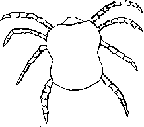 Mites: Mites are the second most common invertebrate found in compost. They have eight leg-like jointed appendages. Some can be seen with the naked eye and others are microscopic. Some can be seen hitching rides on the back of other faster moving invertebrates such as sowbugs, millipedes and beetles. Some scavenge on leaves, rotten wood, and other organic debris. Some species eat fungi, yet others are predators and feed on nematodes, eggs, insect larvae and other mites and springtails. Some are both free living and parasitic. One very common compost mite is globular in appearance, with bristling hairs on its back and red-orange in color.
Mites: Mites are the second most common invertebrate found in compost. They have eight leg-like jointed appendages. Some can be seen with the naked eye and others are microscopic. Some can be seen hitching rides on the back of other faster moving invertebrates such as sowbugs, millipedes and beetles. Some scavenge on leaves, rotten wood, and other organic debris. Some species eat fungi, yet others are predators and feed on nematodes, eggs, insect larvae and other mites and springtails. Some are both free living and parasitic. One very common compost mite is globular in appearance, with bristling hairs on its back and red-orange in color.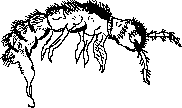 Springtails: Springtails are extremely numerous in compost. They are very small wingless insects and can be distinguished by their ability to jump when disturbed. They run in and around the particles in the compost and have a small spring-like structure under the belly that catapults them into the air when the spring catch is triggered. They chew on decomposing plants, pollen, grains, and fungi. They also eat nematodes and droppings of other arthropods and then meticulously clean themselves after feeding.
Springtails: Springtails are extremely numerous in compost. They are very small wingless insects and can be distinguished by their ability to jump when disturbed. They run in and around the particles in the compost and have a small spring-like structure under the belly that catapults them into the air when the spring catch is triggered. They chew on decomposing plants, pollen, grains, and fungi. They also eat nematodes and droppings of other arthropods and then meticulously clean themselves after feeding. Earthworms: Earthworms do the lion's share of the decomposition work among the larger compost organisms. They are constantly tunneling and feeding on dead plants and decaying insects during the daylight hours. Their tunneling aerates the compost and enables water, nutrients and oxygen to filter down. "As soil or organic matter is passed through an earthworm's digestive system, it is broken up and neutralized by secretions of calcium carbonate from calciferous glands near the worm's gizzard. Once in the gizzard, material is finely ground prior to digestion. Digestive intestinal juices rich in hormones, enzymes, and other fermenting substances continue the breakdown process. The matter passes out of the worm's body in the form of casts, which are the richest and finest quality of all humus material. Fresh casts are markedly higher in bacteria, organic material, and available nitrogen, calcium, magnesium, phosphorus and potassium than soil itself." (Rodale)
Earthworms: Earthworms do the lion's share of the decomposition work among the larger compost organisms. They are constantly tunneling and feeding on dead plants and decaying insects during the daylight hours. Their tunneling aerates the compost and enables water, nutrients and oxygen to filter down. "As soil or organic matter is passed through an earthworm's digestive system, it is broken up and neutralized by secretions of calcium carbonate from calciferous glands near the worm's gizzard. Once in the gizzard, material is finely ground prior to digestion. Digestive intestinal juices rich in hormones, enzymes, and other fermenting substances continue the breakdown process. The matter passes out of the worm's body in the form of casts, which are the richest and finest quality of all humus material. Fresh casts are markedly higher in bacteria, organic material, and available nitrogen, calcium, magnesium, phosphorus and potassium than soil itself." (Rodale)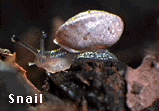 Slugs and snails (left): Slugs and snails generally feed on living plant material but will attack fresh garbage and plant debris and will therefore appear in the compost heap.
Slugs and snails (left): Slugs and snails generally feed on living plant material but will attack fresh garbage and plant debris and will therefore appear in the compost heap.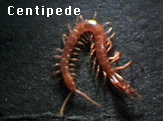
 Millipedes: They are slower and more cylindrical than centipedes and have two pairs of appendages on each body segment. They feed mainly on decaying plant tissue but will eat insect carcasses and excrement.
Millipedes: They are slower and more cylindrical than centipedes and have two pairs of appendages on each body segment. They feed mainly on decaying plant tissue but will eat insect carcasses and excrement.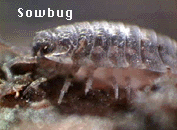 Sow Bugs (right): Sow Bugs are fat bodied crustaceans with delicate plate-like gills along the lower surface of their abdomens which must be kept moist. They move slowly grazing on decaying vegetation.
Sow Bugs (right): Sow Bugs are fat bodied crustaceans with delicate plate-like gills along the lower surface of their abdomens which must be kept moist. They move slowly grazing on decaying vegetation.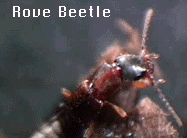 Beetles (left): The most common beetles in compost are the rove beetle, ground beetle and feather-winged beetle. Feather-winged beetles feed on fungal spores, while the larger rove and ground beetles prey on other insects, snails, slugs and other small animals.
Beetles (left): The most common beetles in compost are the rove beetle, ground beetle and feather-winged beetle. Feather-winged beetles feed on fungal spores, while the larger rove and ground beetles prey on other insects, snails, slugs and other small animals. Pseudoscorpions: Pseudoscorpions are predators which seize victims with their visible front claws, then inject poison from glands located at the tips of the claws. Prey include minute nematode worms, mites, larvae, and small earthworms.
Pseudoscorpions: Pseudoscorpions are predators which seize victims with their visible front claws, then inject poison from glands located at the tips of the claws. Prey include minute nematode worms, mites, larvae, and small earthworms.






.jpg)
